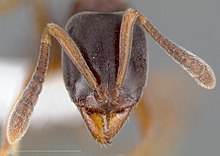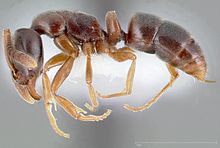en
names in breadcrumbs


The form I call opacior s.s. seems to have a preference for synanthropic and seasonally dry habitats. I have scattered collections from Costa Rica, as follows:
Santa Rosa National Park: in Winkler sample collected by P. S. Ward.
Finca La Pacifica, a dry-forest riparian habitat: in Winkler sample of sifted litter from the forest floor.
Carara Biological Reserve: in Winkler sample collected by P. S. Ward.
Casa Plastico, a 600m elevation wet site on the Atlantic slope, in young second growth at the edge of a pasture: under a mossmat at the base of a tree.
A coffee farm near Heredia in the Central Valley: collected in studies of coffee farm fauna by Ivette Perfecto.
Sirena in Corcovado National Park, a lowland wet forest site: in Winkler sample of sifted litter from the forest floor.
A roadside in Monteverde, where an isolated and epiphyte-laden tree had recently fallen: a nest was under epiphytes near the ground.
La Selva Biological Station, a mature lowland wet forest site: a nest was under epiphytes on a dead branch recently fallen from the canopy.
Fila Cruces near San Vito: a nest was under a stone at the edge of a gravel road through pastures and scrubby forest.
Parque Nacional, a small landscaped park in the middle of San Jose: among a collection of stray foragers.
In contrast, the form JTL-008 I know from La Selva and the adjacent slope of Volcan Barba to about 900m, the Penas Blancas Valley east of Monteverde, and the Wilson Botanical Garden near San Vito. It inhabits mature wet forest, and I usually encounter it in Winkler samples of sifted litter from the forest floor. At La Selva, I collected a nest from beneath the thin, loose bark of some dead wood on the ground.
I tentatively associate an ergatoid male with form JTL-008. It was obtained in a Winkler sample from the Penas Blancas Valley, along with many workers of JTL-008.
Southern half of continental USA, Mexico, Costa Rica, Trinidad, Argentina, Chile, Cuba, Jamaica, Dominican Republic, Puerto Rico, Saint Vincent.
Taxonomic history
Emery, 1895d PDF: 268 (m.); Wheeler & Wheeler, 1964b PDF: 454 (l.).Combination in Hypoponera: Taylor, 1968a PDF: 65.Subspecies of Hypoponera trigona: Emery, 1906c PDF: 116.Raised to species: Kempf, 1962b PDF: 10.
Hypoponera opacior is a species of ant in the family Formicidae.[1][2][3]
Hypoponera opacior is a species of ant in the family Formicidae.
 Ponerine ant, Hypoponera opacior
Ponerine ant, Hypoponera opacior  Ponerine ant, Hypoponera opacior
Ponerine ant, Hypoponera opacior
Hypoponera opacior es una especie de hormiga del género Hypoponera, subfamilia Ponerinae.
Esta especie se encuentra en Belice, Brasil, Costa Rica, República Dominicana, Ecuador, islas Galápagos, Guadalupe, Haití, México, Panamá, Perú, Puerto Rico, San Vicente y las Granadinas, Estados Unidos y Polinesia Francesa.[1]
Hypoponera opacior es una especie de hormiga del género Hypoponera, subfamilia Ponerinae.
Hypoponera opacior is een mierensoort uit de onderfamilie van de Ponerinae.[1][2] De wetenschappelijke naam van de soort is voor het eerst geldig gepubliceerd in 1893 door Forel.
Bronnen, noten en/of referenties